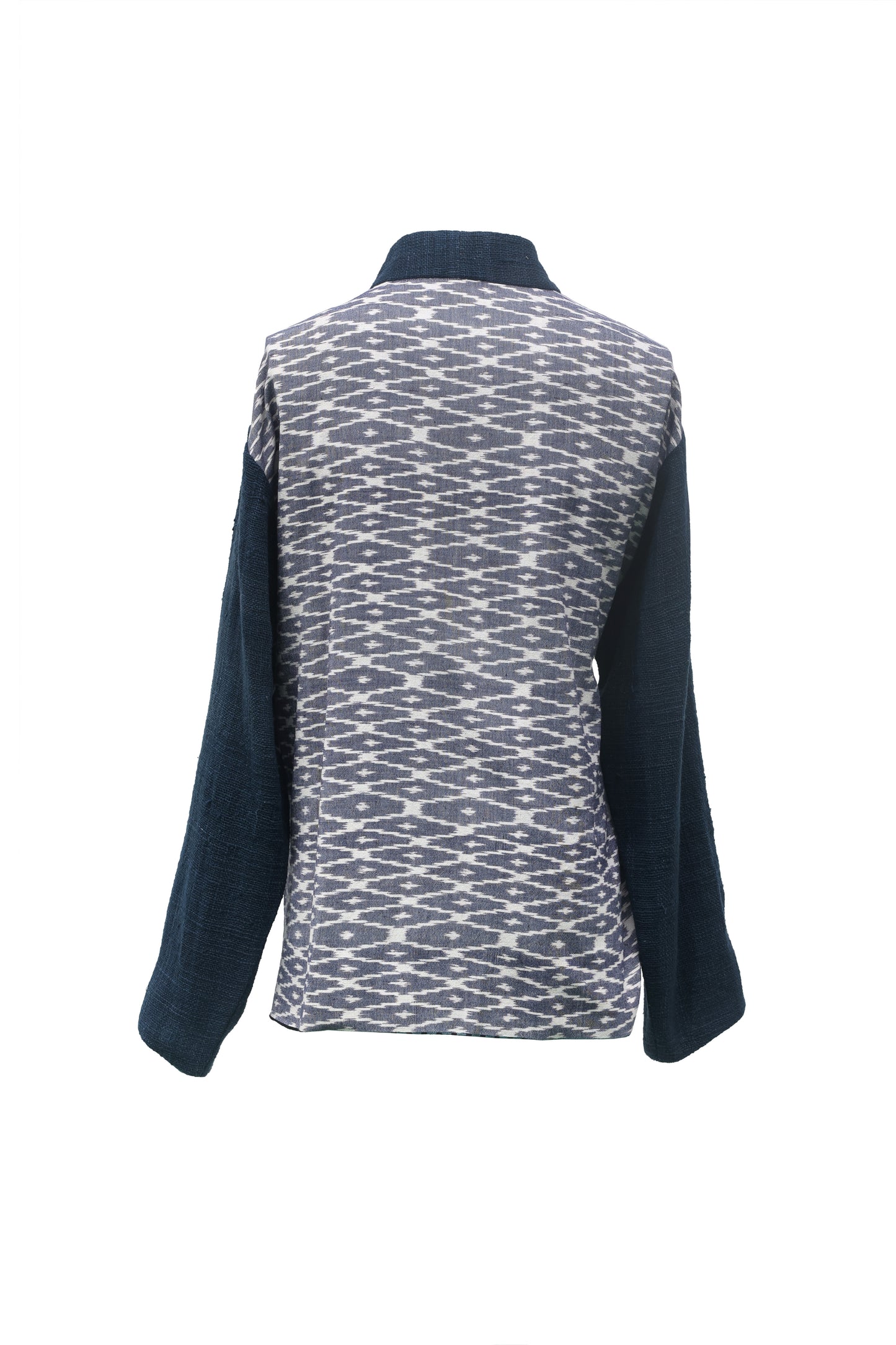KAJ.013
This one of a kind garment is reversible and unique from each side.
Another masterpiece of Karatoyaa indigo range! From one side there is hand woven Mudmee from Thailand, combined with Japanese ai-zome vintage hand woven cotton, and vintage tussar silk combined with Indonesian Ikat on another side.
Indigo was probably introduced to Japan from southern China sometime soon after the fifth century.The oldest evidence of indigo dyeing in Japan dates back to the 10th century. In Japanese, indigo dyeing is known as AI-ZOME. The plants can grow about two and a half feet high. Their stems are green or almost red, and their large leaves are green, but turn dark blue when dried.
In Japan polygonum or tade, is used in the natural indigo dye process. The oldest evidence of indigo dyeing in Japan dates back to the 10th century.
The first ai-zome textiles came to Japan from Southeast Asia. A number of indigo textiles can be found in the 8th century treasure trove in Nara’s Shoso-in Repository (part of Todai-ji Temple). Japanese ai-zome dyeing has its roots in the Heian period (794-1185). By the Kamakura period (1192-1333) the Japanese method was well established.
Japanese ai-zome culture exploded in the Edo period (1600-1868) when laws were passed preventing the lower classes from wearing silk and cotton became the popular alternative. In addition to being readily available (the indigo plant is native to Japan), ai-zome was also color fast on cotton and thus faded slowly, adding to its appeal.
There are five basic materials used in Japanese indigo dyeing: sukumo (the tade leaves of the Japanese indigo plant), fusuma (wheat bran), sake, hardwood ash, and lime.
Ai-zome dyeing is a very complicated and long process. The chemical compound indican contained in the raw leaves is converted into indigo by fermenting the leaves. The traditional process uses only natural materials and no chemicals of any kind. When the fermented indigo solution is ready the cloth is repeatedly soaked in the vat. After squeezing the excess liquid from the textile it is spread wide and hung on a rope. This allows the textile to oxidize and thus fix the color. Just after the textile is removed from the vat it looks dark green. As it oxidizes it turns blue. The soaking and oxidizing steps are repeated over and over until the final desired color has been produced. For the darkest blues soaking lasts 30 minutes and is repeated 30 to 40 times.
Mudmee, or ikat (which it is often called by expatriates), is hand woven Thai silk or cotton fabric that comes from Isaan, Thailand’s Northeastern region that is made up of 17 provinces on the Korat plateau. Ikat (pronounced ‘ee-KAHT’) is derived from the Malaysian word ‘mengikat’, which means ‘to tie/bind’, and is not used by Thais to describe the fabric. Mudmee is produced through the traditional method of tying in the desired pattern with straw, hay or banana ropes. The ropes stop water from affecting the silk or cotton yarns, whilst dyeing it in the process. The tied yarns move through the dyeing process, but only the untied yarns absorb the dye. The method is repeated as many times as necessary, depending on the preferred colour variations. Afterwards, each silk or cotton yarn is woven to create a variety of designs, combining the coloured areas to produce patterns. The mudmee motifs are based on the varieties of patterns and lines. There are three motif variations: weft mudmee, warp mudmee and double mudmee.
Traditionally in Thailand the nobility wore mudmee on a daily basis, whilst others wore it during festive occasions or ceremonies. Nowadays mudmee is worn more casually, though the complexity of the weaving makes it stand out from the majority of casualwear.
Tussar silk originated from medieval period. It is made by collecting the cocoons after silkworms has already emerged. Tribal communities residing in forests collect the cocoons. The magic of this fabric is that keeps you warm in the winter and cool in the summer.
Couldn't load pickup availability
DETAILS
DETAILS
KAJ is our truly unique collection of one of a kind kimono style jackets. Carefully crafted from antique and vintage textiles, that has been collected over the years from all over the world. Each piece is one of a kind, tailoerd to fit different body types and bring a lot of beauty, love and joy to its beholder. Please note that most of the pieces due to antique nature of the fabrics will carry signs of past use.
COMPOSITION
COMPOSITION
UPCYCLED COTTON + SILK
SIZE & FIT
SIZE & FIT
ONESIZE
waist - 146 cm
sleeve - 62cm
CARE
CARE
• Please note, that due to antique nature of the fabrics there may be signs of past experiences - we believe it adds value and a meaning to the garments.
• Some naturally dyed fabrics even after lasting generations may leave colour
• Please keep in mind that all Karatoyaa pieces are Dry Clean only with the Professional service provider.
Share




